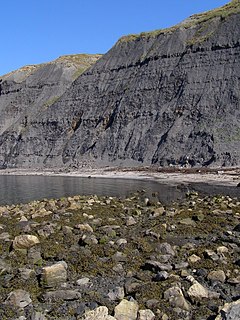| Kimmeridge Clay | |
|---|---|
| Stratigraphic range: | |
 Grey cliffs of Upper Kimmeridge Clay above the beach at Egmont Bight | |
| Type | Geological formation |
| Unit of | Ancholme Group (onshore), Humber Group (offshore) |
| Sub-units | Birch Sandstone Member Burns Sandstone Member Claymore Sandstone Member Dirk Sandstone Member Magnus Sandstone Member Ptarmigan Sandstone Member Ribble Sandstone Member |
| Underlies | Portland Sand Formation, Speeton Clay Formation, Spilsby Sandstone |
| Overlies | Ampthill Clay, Corallian Group |
| Lithology | |
| Primary | Mudstone |
| Other | Siltstone, Sandstone, Conglomerate |
| Location | |
| Region | England (surface) North Sea (subsurface) |
| Country | United Kingdom |
| Type section | |
| Named for | Kimmeridge Bay |
| Location | Type section - North Sea well 47/15- 1 at 885-919 m depth Type area - coastal outcrops from Black Head, Weymouth to Chapman's Pool |
The Kimmeridge Clay is a sedimentary deposit of fossiliferous marine clay which is of Late Jurassic to lowermost Cretaceous age and occurs in southern and eastern England and in the North Sea.[1] This rock formation is the major source rock for North Sea oil. The fossil fauna of the Kimmeridge Clay includes turtles, crocodiles, sauropods, plesiosaurs, pliosaurs and ichthyosaurs, as well as a number of invertebrate species.